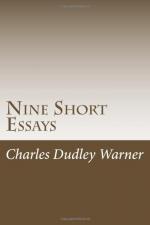I am not sure whether simplicity is a matter of nature or of cultivation. Barbarous nature likes display, excessive ornament; and when we have arrived at the nobly simple, the perfect proportion, we are always likely to relapse into the confused and the complicated. The most cultivated men, we know, are the simplest in manners, in taste, in their style. It is a note of some of the purest modern writers that they avoid comparisons, similes, and even too much use of metaphor. But the mass of men are always relapsing into the tawdry and the over-ornamented. It is a characteristic of youth, and it seems also to be a characteristic of over-development. Literature, in any language, has no sooner arrived at the highest vigor of simple expression than it begins to run into prettiness, conceits, over-elaboration. This is a fact which may be verified by studying different periods, from classic literature to our own day.
It is the same with architecture. The classic Greek runs into the excessive elaboration of the Roman period, the Gothic into the flamboyant, and so on. We, have had several attacks of architectural measles in this country, which have left the land spotted all over with houses in bad taste. Instead of developing the colonial simplicity on lines of dignity and harmony to modern use, we stuck on the pseudo-classic, we broke out in the Mansard, we broke all up into the whimsicalities of the so-called Queen Anne, without regard to climate or comfort. The eye speedily tires of all these things. It is a positive relief to look at an old colonial mansion, even if it is as plain as a barn. What the eye demands is simple lines, proportion, harmony in mass, dignity; above all, adaptation to use. And what we must have also is individuality in house and in furniture; that makes the city, the village, picturesque and interesting. The highest thing in architecture, as in literature, is the development of individuality in simplicity.




